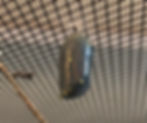Monarch Madness
- Katherine Dudley Hoehn
- Feb 25, 2019
- 3 min read
Updated: Oct 3, 2019

I discovered monarch caterpillars on the milkweed plants blooming in my garden in late January. Although my home is in Florida, I realized they were about to have a very cold night and might not survive. Action required.
Soon I created a very attractive temporary home for the half dozen quickly chilling caterpillars of varying size. I cut milkweed and placed it in pretty, bone china and Waterford vases in a 10-gallon fish tank with a protective top screen and gravel bottom. Only the best for my visitors.
One very cold stunned caterpillar quickly warmed in response to human hands. The rippled skin felt like suede. Soon they voraciously munched the leaves and grew quickly.
The largest caterpillar crawled to the wire top and hung upside down, looking like a clownish letter “J” from a children’s alphabet book. The others visited, perhaps curious about their destiny. I wondered if they were asking it questions, “Does it hurt? Will I know you when you come out?”

The first to form a chrysalis did not mature. Another just quit eating and moving. I had to let that go, acknowledging that in the wild only three percent survive. My remaining four little green beauties were still beating the odds.

A folded butterfly was soon visible inside of chrysalis. Butterfly 1 emerged slowly, unfolding and straightening its wings as meconium pulsed through its system. Eventually the liquid was either expelled, absorbed or a small amount remained and helped strengthen the wings.
I wondered if it remembered being a hungry caterpillar being plucked from a milkweed plant in the cold.

At launch time, I encouraged it to disembark from its perch to the garden milkweed. It seemed stunned by the sudden bright light and lack of boundaries. Watching him finally flap his wings and take off across the yard was a huge thrill and I let out a little shout of support, “you go girl!” After calling him “Madame Monarch” for the whole of his first day of freedom, I learned he was a she. Later I saw him in the neighbor’s garden, happily sampling the nectar buffet.

Butterflies 2 and 3 emerged on schedule and were released, each with the same grace and amazing confidence as they adjusted to sunlight and lack of boundaries.
The fourth chrysalis opened but the emerging butterfly fell, when the time was critical to unfold damp and drying wings. It was never able to open its crinkled wings and tried desperately for most of a day. I sobbed for it and placed it on a flowering plant in the sun for its final hours; there was nothing else I could do. 50 percent release rate was still beating the odds.
I saw a few monarchs in the neighborhood over the next week and happily observed mating behaviors. I hoped Butterfly 2, a female, was one of them.
The next week, I saw one female on my milkweed and I believe she was laying eggs. I was ecstatic and couldn’t take my eyes off of her. Unlike when I released her and she allowed me to observe her closely, this time she flew confidently and circled the plants, but with a heightened sense of danger when I came near. Her brief life of only a few weeks was coming to an end and her whole reason for being was to lay eggs.
Once I see baby caterpillars on my plants again, I’ll have observed the full cycle of monarch life in my garden. I am acquiring pollinator-friendly plants in hopes of attracting future generations of these amazing, delicate creatures. Old lessons I re-learned:
Life is short. Make the most of it.
Nature is profoundly amazing and worth paying attention to.
Sometimes you have to look closely to tell the boys from the girls.
Pollinators are vulnerable and need protecting.
The Florida Museum of Natural Historyin Gainesville has a butterfly rainforest, open to the public. It is on my short list for a spring visit.
There are several other US locations with Butterfly Houses.
When you buy plants for your butterfly garden, check to make sure that they haven't been treated with neonicotinoids or other poisons that could harm pollinators. Protect pollinators from pesticides.

















